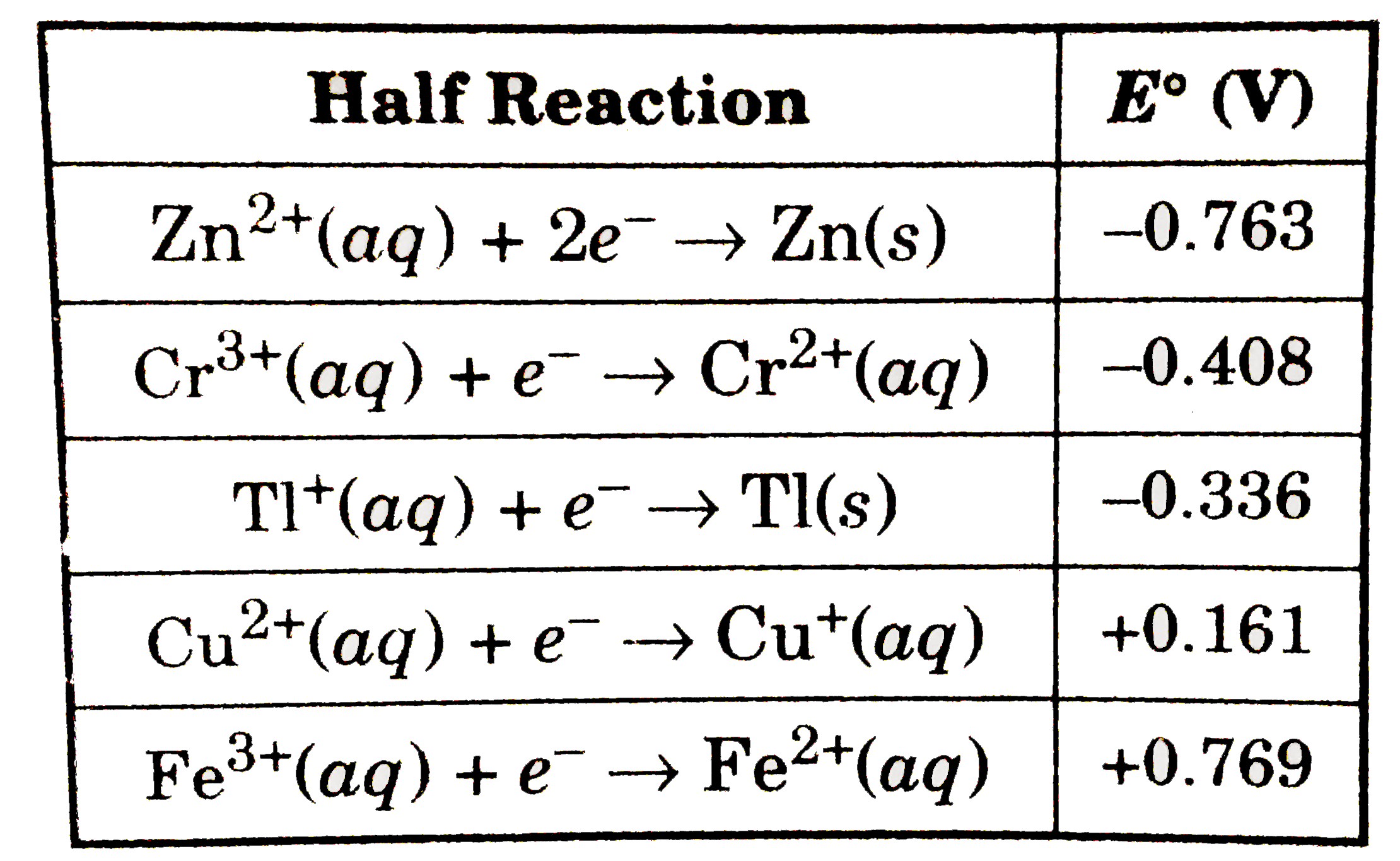Use the information in the table and calcualate E∘ for this reaction.
Ga(s)+3Tl+(aq)→3Tl(s)+Ga3+(aq)
ReactionE∘Ga3+(aq)+3e−→Ga(s)−0.529VTl+(aq)+e−→Tl(s)−0.336V
0.479V
0.193V
−0.193V
0.479V
The correct Answer is:B
Step by step video, text & image solution for Use the information in the table and calcualate E^(@) for this reaction. Ga(s) + 3Tl^(+)(aq) rightarrow 3Tl(s) + Ga^(3+) (aq) {: ("Reaction", E^(@)), (Ga^(3+)(aq) + 3e^(-) rightarrow Ga(s), -0.529V), (Tl^(+)(aq) + e^(-) rightarrow Tl(s), -0.336V):} by Chemistry experts to help you in doubts & scoring excellent marks in Class 12 exams.
Updated on:21/07/2023Topper's Solved these Questions
- ELECTROCHEMISTYBook:GRB PUBLICATIONChapter:ELECTROCHEMISTYExercise:Latimer Diagram, concentration cells
Explore 117 Videos
- ELECTROCHEMISTYBook:GRB PUBLICATIONChapter:ELECTROCHEMISTYExercise:Batteries
Explore 10 Videos
- ELECTROCHEMISTYBook:GRB PUBLICATIONChapter:ELECTROCHEMISTYExercise:Subjective type
Explore 39 Videos
- D-BLOCK ELEMENTSBook:GRB PUBLICATIONChapter:D-BLOCK ELEMENTSExercise:Subjective Type
Explore 18 Videos
- ENVIRONMENTAL CHEMISTRY Book:GRB PUBLICATIONChapter:ENVIRONMENTAL CHEMISTRY Exercise:Straight objective type
Explore 40 Videos
Similar Questions
Given these standards reduction potentials, what is the free energy change (in kJ. Mol^(-) for the reaction:
Pb(s)+2Ag+(aq)→Pb2+(aq)+2Ag(s)
Ag+(aq)+e−→Ag(s) E∘=0.80V
Pb2+(aq)+2e−→Pb(s) E∘=−0.13V
View SolutionWhat is the standard cell potential for the reaction,
2Cr(s)+3Sn2+(aq)→3Sn(s)+2Cr3+(aq)
given the E∘ values shown?

View Solution
Knowledge Check
Nickel metal is added to a solution containign 1.0 m Pb2+(aq) and 1.0MCd^(2+)(aq).Usethestandardreductionpotentials→determinewhichreaction(s)willour.<br>Reaction1:Ni(s) + Pb^(2+)(aq) rightarrow Pb(s) + Ni^(2+)(aq)<br>Reaction2:Ni(s) + Cd^(2+)(aq) rightarrow Cd(s) + Ni^(2+)(aq)<br>{:("Reaction", E^(@)), (Pb^(2+)(aq) + e^(-) rightarrow Pb(s) , -0.13V), (Ni^(2+)(aq) + 2e^(-) rightarrow Ni(s), -0.23V), (Cd^(2+)(aq) + 2e^(-) rightarrow Cd(s), -0.40V):}
A1 onlyB2 onlyCBoth 1 and 2DNeither 1 nor 2What is the value fo ΔG∘0 for the reactions?
2Al(s)+3Cu2+(aq)→+3Cu(s)E∘=2.02VA1170kJB−585kJC−390kJD−195kJWhat is the E∘ value for the voltaic cell constructed from the half-cells?
ReactionE∘(V)Zn2++2e−→Zn−0.762Tl++3e−→Tl−0.036A0.090VB0.426vC1.098vD−0.036V
Given the standard reduction potentials, which statement is correct?
Cu2(aq)+2e−→Cu(s)E∘=0.34V2H+(aq)+2e−→H2(g)E∘=0.0VCr3+(aq)+2e−→Cr(s)E∘=−0.73V
View Solution
Use the standard reduction potentials to find the standard cell potential E∘, for the reaction:
Zn(s)+2Tl+(aq)→Zn2+(aq)+2Tl(s)
View SolutionWhich expression gives the correct value of the standard potential for a gold-rhodium voltaic cell?
Half-reactionE∘VRh3+(aq)+3e−→Rh(s)0.76Au+(aq)+e−→Au(s)1.69
View SolutionUsing the above information, determine the standard reduction potential for the following reaction,
2M(s)+3Zn2+(aq)→
2M3+(aq)+3Zn(aq),E∘=0.90V
Zn2+(aq)+2e−→Zn(s),E∘=−0.76V
View SolutionGiven these standard reduction potentials, what is the standard reduction potential for
Co3+(aq)+3e−→Co(s)?
Co3+(aq)+e−→Co2+(aq)E∘=1.82V
Co2+(aq)+2e−→Co(s)E∘=−0.28V
View Solution